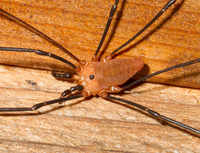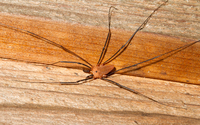Distribution Records
PDF
Vetting Levels |
|
Adult phenology:
High Mountains (HM) ≥ 4,000 ft.
Low Mountains (LM) < 4,000 ft.
Piedmont (Pd)
Coastal Plain (CP)
Click on graph to enlarge
|
 |
|
| synonym | |
| taxonomic_comments |
Approximately 30 species in this genus have been identified as occurring in North America north of Mexico (Cokendolpher and Lee, 1993; Ingianni et al., 2011), with 16 recorded in North Carolina. However, the validity of several of these species is suspect, with several that will probably be determined to be synonyms of other species, e.g., davisi, speciosum, and zimmermani in North Carolina Burns et al., 2012; Shultz, 2018). According to Shultz (2018), moreover, recent phylogenetic studies indicate both that more species are waiting to be described and that the name Leiobunum may eventually be restricted to European species, requiring new generic names for most, if not all, of our species. |
| species_comment |
Belongs to the Leiobunum Calcar Species Group as described by Ingianni et al. (2011), based on both male and female reproductive structures; further confirmed by genetic analysis (Burns et al., 2012). Other North Carolina species in this group include nigropalpi, euserratipalpe, and calcar. |
| id_comments |
The dorsal surface of the males is typically light orange brown, similar to the males of calcar (Ingianni et al., 2011). The ocularium is dark brown and the abdominal tergites are marked by rows of light spots; the central figure is usually absent. In some males, however, a well-developed central figure is present and the dorsum is highly patterned with dark and white patches. Coxae, trochanters, and femurs of the legs are all golden brown. The chelicerae and palps are mainly dark brown. |
| total_length |
6.5 mm, male holotype; 7.6 mm, female paratype (Ingianni et al., 2011) |
| structural_features |
The palps of the males are conspicuously inflated and usually have a large, retrolaterally projecting cone on the femur, similar to that of male calcar (missing in some individuals). The abdomen is pointed posteriorly in the males, again similarly to calcar. In the northwest corner of North Carolina, where these two species overlap, identification of both males and females requires microscopic examination of the reproductive structures and other key characters. Females in general are best identified by their reproductive structures (see key in Ingianni et al.). |
| silk_web |
|
| fld_guide_descriptions |
|
| online_photos |
|
| prey |
|
| predators |
|
| behavior |
|
| distribution_reference |
Ingianni et al. (2011) |
| technical_reference |
Ingianni et al. (2011) |
| adult_id | 1 identifiable by photo 2 identifiable by photo of specific features and/or supplementary info 3 identifiable from specimen only |
| abundance |
Hoffmani was commonly observed at bait at one site in Ashe County. However, we currently have too few records from North Carolina to accurately judge its frequency of occurrence or abundance. |
| distribution_comments |
So far known only from the extreme northwestern corner of the state |
checklist_mt_high
>=4,000 ft. | |
checklist_mt_low
<4,000 ft. | |
checklist_pd
Piedmont | |
checklist_cp
Coastal Plain | |
| habitat |
Many of the records from Virginia come from the Spruce-fir zone at the summit of the highest peaks in that state (Ingianni et al., 2011). The two North Carolina records, however, come from relatively low elevations, 3,600' for one site and about 2,200' at the other. At the Ashe County location, the species was observed along a ridge top with an extensive stand of relatively mature cove hardwoods located on the north-facing slope. |
| observation_methods |
This species appears to come well to beer-banana bait painted on trees. It appears to be most active at night, but has also been found during the day on the outside of an out-building. |
| state_protection |
Arachnids are not protected under state law, although permits are needed to collect them in State Parks and other public and private nature preserves |
| NHP_ranks |
GNR [S2S3] |
| NHP_status |
[W3] |
| status_comments |
The global rank of this species has not yet been determined, but it currently appears to occupy a very small range in the southern Blue Ridge. Hoffmani has so far been recorded from only two sites in North Carolina and there is much to be learned about its habitat associations, distribution, abundance and population trends. |
Photo Gallery for Leiobunum hoffmani No common name |
 | Recorded by: Steve Hall
Ashe Co.
Comment: Male; found on outside of a well-house. Appears to be the variant of hoffmani that lacks the retro-lateral projection on the palpal femur |  | Recorded by: Steve Hall
Ashe Co.
Comment: Male; found on outside of a well-house. Appears to be the variant of hoffmani that lacks the retro-lateral projection on the palpal femur |
|